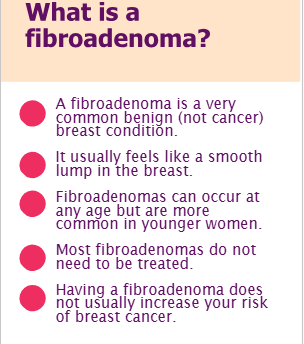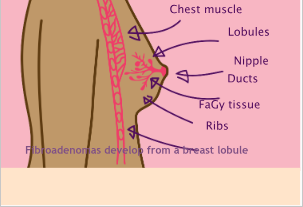Benign breast conditions information provided by Breast Cancer Now


Symptoms of fibroadenoma
A fibroadenoma usually feels like a smooth lump in the breast that moves easily under the skin.
Fibroadenomas are usually painless. Sometimes they may feel tender or even painful, particularly just before a period.
See your GP if you notice a lump in your breast.
Who fibroadenomas affect
Younger women
Fibroadenomas often start to develop during puberty.
They are commonly found in women in their 20s and 30s.
Women of any age
While more common in younger women, fibroadenomas can occur at any age. This means they can affect women who have been through the menopause.
Sometimes a fibroadenoma might be found during routine breast screening.
Men
Although very rare, men can get fibroadenomas.
Fibroadenomas in men are diagnosed and treated in the same way as in women.
Types of fibroadenoma
Simple fibroadenoma
Most fibroadenomas are about 1 to 3cm in size and are called simple fibroadenomas.
When looked at under a microscope, simple fibroadenomas look the same all over.
Simple fibroadenomas do not increase the risk of developing breast cancer in the future.
Complex fibroadenoma
Some fibroadenomas are called complex fibroadenomas. When these are looked at under a microscope, some of the cells have different features.
Having a complex fibroadenoma can very slightly increase the risk of developing breast cancer in the future.
Giant fibroadenoma
Occasionally, a fibroadenoma can grow to more than 5cm. This may be called a giant fibroadenoma.
Giant fibroadenomas most commonly develop during pregnancy or breastfeeding.
Juvenile fibroadenoma
A fibroadenoma found in teenage girls may be called a juvenile fibroadenoma.
Multiple fibroadenomas
While most people have a single fibroadenoma, it’s possible to have more than 1.
Visit breastcancernow.org
Causes of fibroadenoma
It’s not known what causes fibroadenomas, but it’s thought they may occur because of the effects of the hormone oestrogen.
Breasts are made up of milk-producing glands (lobules) and tubes that carry milk to the nipple (ducts). These are surrounded by tissue that gives the breasts their size and shape.
Fibroadenomas develop from a lobule. Tissue and ducts grow over the lobule and form a solid lump.
Diagnosis
If you see your GP because of a breast lump, they’re likely to refer you to a breast clinic.
At the breast clinic you’ll have a range of tests which may include:
- An ultrasound scan (using sound waves to produce an image)
- A mammogram (breast x-ray)
- A biopsy (using a needle to take a small sample of tissue to be looked at under a microscope)
Fibroadenomas are often easier to identify in younger women.
If you’re under 25, you’re less likely to need a biopsy to confirm whether you have a fibroadenoma. However, you may have a biopsy if there’s any doubt about the diagnosis.
If you’re under 40, you’re more likely to have an ultrasound than a mammogram.
Younger women’s breast tissue can be dense which can make a mammogram less clear.
However, some women under 40 may need a mammogram to complete their assessment.
For more information about tests you may have, see our booklet Your breast clinic appointment.
Treatment and follow-up Most fibroadenomas do not need treatment
In most cases you will not need any treatment or follow-up if you have a fibroadenoma.
Usually you’ll only be asked to go back to your GP or the breast clinic if a fibroadenoma gets bigger or you notice any other changes.
Can fibroadenomas change size?
Most fibroadenomas stay the same size.
Some get smaller and some eventually disappear over time.
A small number of fibroadenomas get bigger, particularly those in teenage girls.
Fibroadenomas can also get bigger during pregnancy and breastfeeding or while taking hormone replacement therapy (HRT), but usually reduce in size again afterwards.
Surgery
If you have a giant, complex or juvenile fibroadenoma, you may be recommended an operation to remove it.
You can also ask to have a fibroadenoma removed, for example if it’s causing discomfort or pain. However, removing the fibroadenoma will not always relieve these symptoms.
The operation is called an excision biopsy and is usually done under general anaesthetic.
Your surgeon will discuss with you the possible size and place of the scar.
Vacuum assisted excision biopsy
You may be offered a vacuum assisted excision biopsy to remove a small fibroadenoma.
After an injection of local anaesthetic, a small cut is made in the skin.
A special needle connected to a vacuum device is placed through this. Using an ultrasound as a guide, the fibroadenoma is sucked through the needle by the vacuum into a collecting chamber.
The biopsy device is used until all the fibroadenoma has been removed.
The removed tissue is sent to a laboratory and examined under a microscope.
This procedure can cause some bruising and pain for a few days afterwards.
Removing a fibroadenoma does not usually affect the shape of the breast, but there may be a slight dent in the breast where it has been removed.
Does a fibroadenoma increase the risk of breast cancer?
For most people, having a fibroadenoma does not increase the risk of developing breast cancer.
If you were diagnosed with a complex fibroadenoma, your risk is very slightly increased. If you’re worried about your risk of breast cancer, you can speak to your GP or breast team.
It’s important to be breast aware and go back to your GP if you notice any changes in your breasts, no matter how soon after your diagnosis of a fibroadenoma.
ABOUT THIS LEAFLET
Fibroadenoma was wriGen by Breast Cancer Now’s clinical specialists, and reviewed by healthcare professionals and people affected by breast conditions.
For a full list of the sources
we used to research it: Email health- info@breastcancernow.org
You can order or download more copies from
breastcancernow.org/publications
We welcome your feedback on this publication:
health-info@breastcancernow.org
For a large print, Braille
or audio CD version: Email
health-info@breastcancernow.org
Medical disclaimer
We make every effort to ensure that our health information is accurate and up to date, but it doesn’t replace the information and support from professionals in your healthcare team. So far as is permiGed by law, Breast Cancer Now doesn’t accept liability in relation to the use of any information contained in this publication, or third-party information included or referred to in it
Lahore Clinic
- 0324 9780880
- info@drahsanrao.com
- One-stop Clinic (surgical-review,breast ultrasound scan and mammogram, biopsy all in same clinic)
- Shaukat Khanum Hospital Rd, Block R3 Block R 3 Phase 2 Johar Town, Lahore, 54000
Timings
- Assistant : Adeel
- 0324 9780880
- Timings: Tuesday (9 AM to 5 PM) Wednesday (2 PM to 6 PM) Telephonic:(6 PM to 8 PM)
- Copyright © 2024 Dr. Ahsan Rao All rights reserved.

